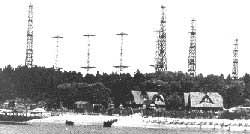Robert Watson Watt is now almost forgotten even though he was the man who helped win the Battle of Britain and whose invention went on to lay the foundations for a host of modern life-saving technologies. According to today’s Independent The recently formed Watson-Watt Society wants to raise £50,000 to build a memorial statue in his home town, Brechin in Scotland, to the man who is officially credited with creating the first workable radar system.
A descendant of James Watt, the engineer and inventor of the steam engine, Watson-Watt's method of using radio waves to detect objects helped tilt the balance of air superiority in 1940 when the overstretched RAF was able to intercept enemy bombers in all weathers and at night. Without it, Britain would have probably lost the battle. His system of "radio detection and ranging", which was later shortened to "radar", came about by accident as Watson-Watt had initially been involved in trying to find a way of predicting thunder and lightning to warn aviators.
An unassuming man, Watson-Watt was born in Brechin, Angus, in 1892 and was educated at Damacre School in Brechin and Brechin High School before graduating with a BSc(engineering) in 1912 from University College, Dundee - which was then part of the University of St Andrews. At the start of the First World War, he was offered a post at the Meteorological Office, which was interested in his ideas on the use of radio for the detection of thunderstorms. Lightning gives off a radio signal as it ionizes the air, and he planned on devising a method of detecting that signal in order to warn pilots of approaching thunderstorms. However, while carrying out experiments he found that aircraft could also be detected without being seen and - as a result - discovered the underlying science of radar.
The Scottish physicist first developed a working radar system in 1935 but it was not until 1937 that the Chain Home radar system became operational, linking stations along the south coast of England in a relay that could detect aircraft approaching the UK at a range of more than 100 miles. In 1942, Watson-Watt's work was officially recognised with a knighthood and in the 1950s he moved to Canada and later lived for a short time in the United States. Eventually, he retired and returned to Britain until his death in 1973 at the age of 81.
Brian Mitchell, secretary of the Watson-Watt Society, said "Watson-Watt's work was extremely important during the Second World War and has been further developed into today's air traffic control systems. It was feared that German aircraft would be able to flatten every town in the country as their bombers could approach Britain from altitudes that were out of reach to anti-aircraft guns. Watson-Watt developed the system to detect and locate the threat by radio methods. A statue or sculptured stone monument will be a fitting memorial to our most famous son,"
Click here for a biography of Watson-Watt and here for information avout the Chain Home radar system
Watson-Watt radar


2 comments:
So, Watson Watt invented the radar, then who invented the homosexual device of "Gaydar?"
Seriously though, even though you're now an avowed agnostic, can't you see divine inspiration in such remarkable intelligence and development of breathtaking new technology? It's amazing the process of thought individual humans can manifest...
It really is amazing how people make such connections. It really is, ewbl!
Post a Comment